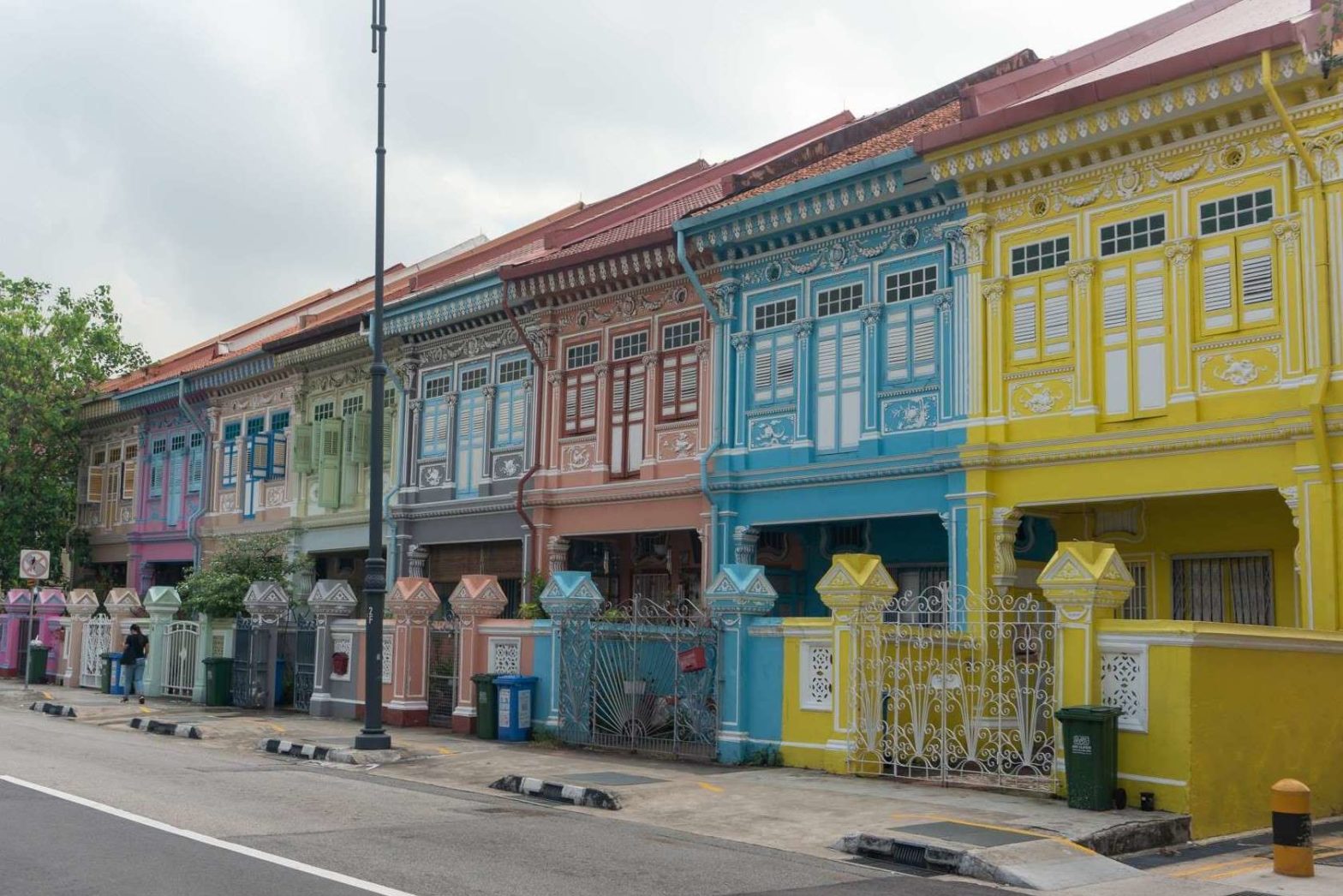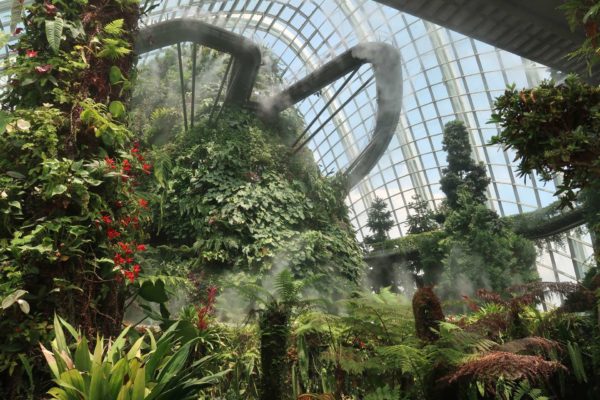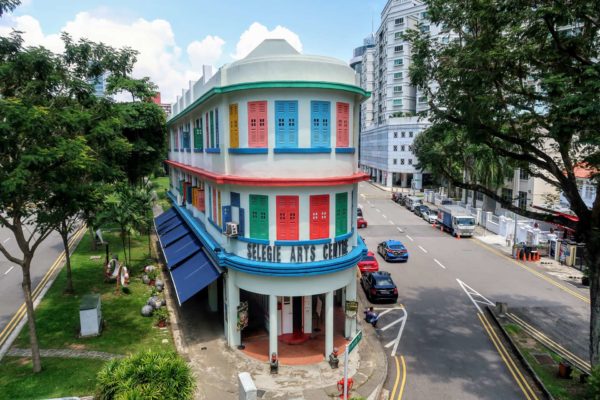By Vicky · Published Mar. 11th, 2022 · Updated Jan. 21st, 2023
When you buy through links highlighted with an asterisk (*) on this site, we may earn a small affiliate commission at no cost to you.
Walk through Joo Chiat and Geylang to discover quaint shops and beautiful shophouses, and immerse yourself in Peranakan, Malay and Eurasian culture.
Page Contents:
How to get to Joo Chiat and Geylang
Joo Chiat is a road in the district of Geylang in eastern Singapore, between the airport and downtown. This walking trail starts at Paya Lebar MRT Station on the green East-West and orange Circle Lines. Leave via Exit C. There are also several buses that ply Geylang Road.
Joo Chiat Heritage Trail Map
Get the route by downloading the .gpx or .kml file below. For navigation with Maps.me on your mobile phone, simply download the .kml file and open to add it to the Maps.me bookmarks.
Tips for Joo Chiat and Geylang Walk
- Early mornings or late afternoons are a good time to enjoy this walk to avoid the heat of the day.
- Plan to sample the delicious food, whether for brunch, lunch, afternoon snacks or dinner.
- Geylang Serai Market is busiest on weekends mornings – many of the produce stalls close after lunch, but the hawker centre stays open.
- To shorten the walk, head straight to Geylang Serai Market from Paya Lebar MRT.
- For a longer walk, continue down to East Coast Park from East Coast Road.
- For more heritage walks, check out our Singapore Walks Page.
Attractions on the Joo Chiat and Geylang Walk
On this walking trail you’ll see the main sites and attractions of Joo Chiat and Geylang districts:
- Sri Sivan Temple
- Geylang Road
- Geylang Serai Market
- Joo Chiat Complex
- Joo Chiat Road
- The Intan
- Eurasian Heritage Gallery
- Koon Seng Road Shophouses
- East Coast Road
- Sri Senpaga Vinayagar Temple
This is a self-guided walking tour. If you prefer to go on a guided tour, check out this great Joo Chiat Peranakan Experience*.
Joo Chiat and Geylang Walking Route
This walking trail starts from Paya Lebar MRT Station Exit C.
Directions: First head down the main Paya Lebar Road.
You’ll immediately see a pretty green and white mosque, Masjid Wak Tanjong. The other side of the mosque is the striking red and white Former Geylang Fire Station, in operation from 1929 until 2002.
Directions: Return back to the MRT Exit and now walk left underneath the covered walkway by a car park. Soon a field appears to your right and you should be able to see the temple of the first stop on the opposite side of the grass.
1. Sri Sivan Temple
Sri Sivan Temple (Website, Tripadvisor Reviews*) is a Hindu temple dedicated to Lord Shiva. To plan the design, a team went to India to study the architecture of the best temples in both the north and the south. The building they came up with has a unique octagonal structure and has been here since 1993. It’s open daily 6am–12pm and 5:30–9pm.
Next door to the left is Foo Hai Ch’an Monastery (Tripadvisor Reviews*). This is a Buddhist Monastery, founded in 1935. It has zen architecture and contains several Buddhist relics and a Boddhi tree. It’s open daily 9am – 4pm.
Directions: Head left down the road underneath the metro. When you hit the main road, Sims Avenue, turn left. Then take one of the smaller roads that head right to cut through to Geylang Road.
2. Geylang Road
Low-rise antique shophouses line Geylang Road. It’s a little busy, but off to the north and south side are quieter lanes which also have nice shophouses. The Road is one of the oldest in Singapore and used to have an electric tram running down the middle. Originally, the Geylang River separated mainly Malays living in traditional farming villages on the east, from Chinese to the west who set up shophouses.
Before you get to the busy crossing with Guillard Road, look right and you will see the white colonial-style building of the Former Queen’s Theatre at the end of a little street. This used to be a cinema, opened in the 1930s and closed in 1982. The facade remains but it’s now just part of a mall.
Directions: Continue walking along Geylang Road, across the busy road junction and the river. In about 500 metres you’ll be at the top of Joo Chiat Road and right by the famous market.
3. Geylang Serai Market
Key Information: Open 6am-9pm, though some stalls close after lunch.
Geylang Serai Market (Website, Tripadvisor Reviews*) contains a delight of Malay and Muslim food. It’s in a two-story building with a striking roof representing a traditional kampong house. On sale are the normal fruits, vegetables, meat and fish, along with kuih (sweetmeats), Malay textiles and snacks such as rempeyek (fried flour with spices and peanuts encrusted on them). Along with produce, there’s a hawker centre upstairs selling delicious food of all kinds.
Geylang Serai Market is built on a former lemongrass factory, as its name suggests: Geylang comes from the Malay word kilang, which means factory or workshop. Serai is Malay for lemongrass, a tasty plant used heavily in Southeast Asian cooking.
The large fancy building to the left of the market is Wisma Geylang Serai, a community event space. It’s designed in the style of a traditional Malay kampong, with a double-pitched roof and stilts.
Directions: Cross to the other side of Geylang Road using the pedestrian bridge and head straight into the mall opposite.
4. Joo Chiat Complex
Key Information: Open daily 9:30am-9pm.
Joo Chiat Complex (Website, Tripadvisor Reviews*) is an old-school mall where trade has taken place since the 1960s. Although bland on the outside, inside it feels like a market with Malay with Islamic vibes. You can buy traditional crafts and clothing here, including batik, Malay CDs and DVDs and jamu – traditional herbal remedies. Be prepared to bargain.
Directions: Leave the mall and you’re at the top of Joo Chiat Road.
5. Joo Chiat Road
At the eastern end of Geylang Road, Joo Chiat Road strikes perpendicular, heading down towards the ocean. Joo Chiat Road itself is 1.5 km long and ends at East Coast Road where Katong District is. The top part of the road has more authentic stores and also more cars, while towards the south it becomes hipster and the buildings are nicer.
At the top of this road, on your right is Hjh Maimunah (Website, Tripadvisor Reviews*), a very popular and inexpensive traditional Malay diner. Try the nasi lemak, or ayam bakar sunda (Sundanese-style barbecue chicken).
Directions: Continue 200 metres down the road until the junction with Joo Chiat Terrace.
Just beyond this junction, on the left, is Kway Guan Huat (Website, Tripadvisor Reviews*). It’s a famous, traditional family diner and one of the best places in Singapore for spring rolls, or Popiah as they’re called locally. You can eat in or there are many snacks or produce to take away.
Directions: Head left on Joo Chiat Terrace.
You pass some lovely shophouses on the left, with ornate faces, beautiful tiles and traditional five-foot ways to shelter from the sun and rain.
Directions: The next stop on your left, just after the terraced shophouses.
6. The Intan
Key Information: You can only visit on a guided tour, check the website for timings. Book in advance on the website or on Klook*. For a more in-depth experience, you can visit this museum as part of a half-day Peranakan and Eurasian Heritage Tour*.
The Intan (Website) is a small, private museum full of Peranakan furniture and antiques. The tours are fairly expensive (about $65 per person), but they include snacks and tea. The museum is jam-packed with stuff, everything from cabinets to beaded slippers. Your tour guide will tell you about Peranakan history and culture and how it relates to the items displayed.
Directions: Continue a short distance along Joo Chiat Terrance and then take a right on Everitt Road.
Everitt Road
Just around the corner on the right is the Jousting Painters Mural by Ernest Zacharevic.
Directions: Continue walking down Everitt Road, past some shophouses on your right.
At the first junction look left down Joo Chiat Place and you’ll see a row of uniform, well-maintained white terraced shophouses. These are from the 1930s. Note the wooden swing half-doors, just like in the Wild West, enabling the occupants to open the main doors to get a breeze while retaining some privacy.
Directions: Head right to return to Joo Chiat Road, then continue left down the road.
Continuing down Joo Chiat Road
You begin to see some of the shophouses and hipster restaurants and cafes on this stretch of the road. At the junction with Joo Chiat Lane, you’ll see Common Man Coffee Roasters Joo Chiat (Website, Tripadvisor Reviews*) on the corner, in a gorgeously embellished shophouse from 1928.
Directions: Pop down Joo Chiat Lane and left around the corner on Tembeling Road.
The front and best view of Kuan Im Tng Temple (Website, Tripadvisor Reviews*) is on Tembeling Road. This temple celebrates three religions, Buddhism, Taoism and Confucianism. Devotees study Taoist philosophy, live their lives according to Confucian principles, and recite Buddhist mantras to obtain good karma.
Directions: Return to Joo Chiat Road and head left.
Shortly on your left, you can see Kuan Im Kuan Ti Kong Temple in an old Anglo-Malay building. Just next to it is a similar building but in a state of disrepair, though still with ramshackle elegance.
Directions: Just after the temple head right on Ceylon Lane and at the end of the road you’ll see the next stop.
7. Eurasian Heritage Gallery
Key Information: Open 10am – 5pm every day except Mondays. Free/$5 locals/international. Half-day Eurasian Heritage Tours (including lunch) are offered on Klook*, or you can take part in a half-day Peranakan and Eurasian Heritage Tour* to visit The Intan as well.
The Eurasian Heritage Gallery (Website, Tripadvisor Reviews*) is a small but interesting space with several galleries. These relate to how Eurasians have been influential in the history of Singapore, their culture and Eurasians in Singapore today. Contains Quentin’s the Eurasian Restaurant.
Directions: Return to Joo Chiat and head right to continue along the road. Soon you’ll reach the junction with Koon Seng Road – head left along here.
8. Koon Seng Road Shophouses
The Koon Seng Road Shophouses are some of the most colourful and photographed shophouses in Singapore. Their bright pastel colours, ornate tiles and fancy detailing make them stand out. The houses were built in the 1920s for Chinese Peranakan families, but by the 1950s the area had gone downhill and was known for crime, so many families left the street. The area recovered and these shophouses now have conservation status.
The nice section of Koon Seng Road isn’t very long, just a 50-metre stretch from Joo Chiat Road. You may have to wait a while to get a photo without any cars since this is actually quite a busy road. If you continue to the junction with Tebelling Road, there are also several nice shophouses a short way to the right.
Directions: Return to Joo Chiat Road.
Continuing Down Joo Chiat Road
On the corner opposite is Mr & Mrs Moghans Super Crispy Prata (Tripadvisor Reviews*), a stall that sells the best roti prata at a great price. It’s actually within Tin Yeang Restaurant on the corner of Dunman Road. It’s very popular and the main drawback can be the long waiting times.
Slightly further down the road, Teong Theng Co sells rattan furniture. This type of furniture used to be very common, but now this is the only traditional shop left selling these unique chairs and tables.
As you continue walking down the road, there are many cafes and little shops. Just before the corner with East Coast Road is Awfully Chocolate (Website, Tripadvisor Reviews*), a delicious bakery and cafe serving baked goodies and delicious desserts.
Directions: Walk right along East Coast Road.
9. East Coast Road
East Coast Road forms the end of the nice section of Joo Chiat Road. There are some interesting shops and yet more nice Peranakan shophouses here. Along this road are several places to get delicious food unique to this district. You can sample the best on a specially tailored eating tour*.
Soon on your right is Rumah Bebe (Website, Tripadvisor Reviews*), a Peranakan cafe, restaurant and shop that also offers traditional beading classes and tours (open Thu-Sun). You can join Nonya cooking classes, or make traditional beaded Peranakan shoes. They sell many books on Peranakan heritage, as well as unique Peranakan kueh (sweet treats).
Next door is Kim Choo Kueh Chang (Website, Tripadvisor Reviews*), a cute shop famous for rice dumplings and desserts. It’s open daily 10am-9pm. You can get some small discounts by buying a voucher in advance*.
Don’t miss the bright yellow alley next to Kim Choo Kueh Chang, head in to see the beautiful Medley Alley / Wings Mural created using colourful tiles.
Further along East Coast Road, in a white building on the corner, is 328 Katong Laksa (Website, Tripadvisor Reviews*). This restaurant is famous for its Laksa – prawns, seafood, noodles and coconut milk – a local speciality.
Directions: Turn right down Ceylon Road just after 328 Katong Laksa. Fifty metres along is the next and final stop on this walking tour.
10. Sri Senpaga Vinayagar Temple
Sri Senpaga Vinayagar Templer (Website, Tripadvisor Reviews*) is a Hindu temple dedicated to Lord Ganesh (whose other name is Vinayagar). Someone found a statue of this deity by a pond here in the 1850s, and decided to start this temple nearby. It was built by the Tamil community from Ceylon (Sri Lanka). Notice that the gopura (entrance gate tower) is not multicoloured but cream and the deities are pinky brown.
This is the last stop on the Joo Chiat and Geylang Walking Trail.
Directions: Head back to East Coast Road. On your right is a bus stop, and opposite is the bus stop to head back towards town. There are also many other bus stops in the neighbourhood.
What to eat in Joo Chiat?
Katong Laksa is a speciality of the area, a combination of noodles and seafood in a coconut milk broth. Geylang Serai Market is a great place to try Nasi Lemak or other Malay dishes. Bak Chang, sticky rice dumping, are another speciality to look out for.
Kueh, sweet snacks or desserts, can be found in many little shops here and they’re great for energy to keep walking. If you haven’t had roti prata yet, head straight for Mr & Mrs Moghans and add a teh tarik to refresh yourself.
If you want to experience another Singapore walking trail, why not check out our Colonial District, Chinatown, Marina Bay, Kampong Glam Walking Trail or Little India Walking Trail. For more walks, check out our Singapore Hiking Page.
FAQS – Joo Chiat and Geylang Walk
Joo Chiat is known for its Peranakan culture, delicious food and beautifully ornate shophouses.
Geylang comes from the Malay word kilang, which means factory or workshop. Serai is Malay for lemongrass, a tasty plant used heavily in Southeast Asian cooking. There used to be a lemongrass factory where the Geylang Serai market is today!
To get to Joo Chiat take the MRT Paya Lebar MRT Station on the green East-West and orange Circle Lines. From there it’s a 500-metre walk to the top of Joo Chiat Road. Alternatively, there are many buses that head along both Geylang and East Coast Roads, at either end of Joo Chiat.
Joo Chiat is named after a famous Peranakan Chinese businessman, Chew Joo Chiat. In his time he owned most of the land in this area, where all the streets are now named after him.





